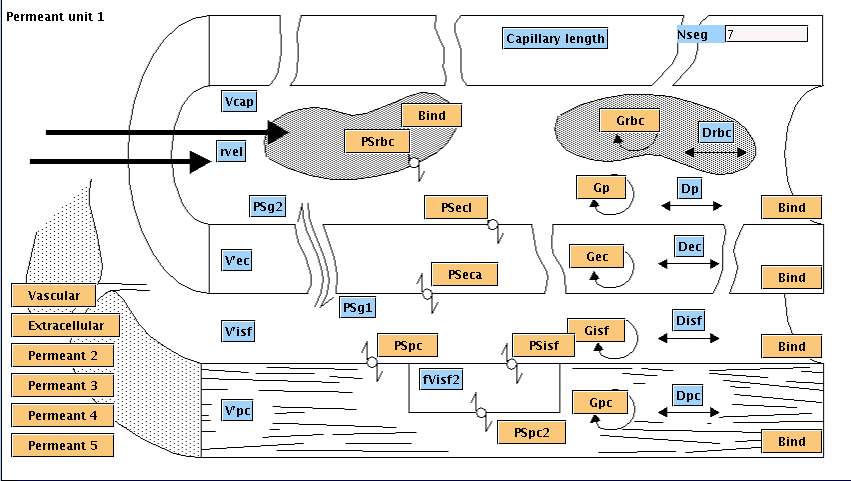GENTEX is a whole organ model of the vascular network providing intraorgan flow heterogeneity and accounts for substrate transmembrane transport, binding, and metabolism in erythrocytes, plasma, endothelial cells, interstitial space, and cardiomyocytes.
Description
GENTEX is a GENeric Tissue EXchange model characterizing the flow and transformation of metabolites. GENTEX is a whole organ model of the vascular network providing intraorgan flow heterogeneity and accounts for substrate transmembrane transport, binding, and metabolism in erythrocytes, plasma, endothelial cells, interstitial space, and cardiomyocytes.

Equations
- Flow velocities inside the capillary:
- In a large vessel, the blood flow can be partitioned between plasma (p) flow and red blood cell (rbc) flow. The flows are given by:
Fp = Fblood*(1-hLV) and Frbc = Fblood*hLV
and the corresponding volumes are given by:
Vp = Vblood*(1-hLV) and Vrbc = Vblood*hLV,
where hLV stands for the hematocrit in the large vessel.
It is easily seen that the velocities of plasma and rbcs are the same in the large vessel. (Velocity=Flow*Length/Volume).
It has been noted that hematocrit inside capillaries, hc, is different then the hematocrit inside the large vessel supplying them. Since the volumes of plasma and rbc in the capillaries depend on hc, the volumes are different in the capillaries than in the large vessel. Hence the ratio of velocities must be different.
Using:
Vpcap=Vblood*(1-hc) and Vrbccap=Vblood*hc,
the ratio of velocities is given by:
RatioVel=(Frbc*L/Vrbccap)/(Fp*L/Vpcap) = hLV*(1-hc)/( (1-hLV)*hc ).
If the Ratio of velocities is known, the capillary plasma hematocrit is given by:
hc = hLV/(hLV-RatioVel*HLV +RatioVel). - Permeant Equations:




Initial Conditions:
 ,
,  ,
,  ,
, 
Boundary Conditions:

 ,
, 
 ,
, 
 ,
, 
 ,
, 
- Extracellular Equations:


Initial Conditions:


Boundary Conditions:




- Vascular Equations:





- Download JSim model MML code (text):
- Download translated SBML version of model (if available):
- No SBML translation currently available.
- Information on SBML conversion in JSim
We welcome comments and feedback for this model. Please use the button below to send comments:
Poulain CA, Finlayson BA, Bassingthwaighte JB.,Efficient numerical methods for nonlinear-facilitated transport and exchange in a blood-tissue exchange unit, Ann Biomed Eng. 1997 May-Jun;25(3):547-64. Bassingthwaighte JB, Raymond GR, Ploger JD, Schwartz LM, and Bukowski TR. GENTEX, a general multiscale model for in vivo tissue exchanges and intraorgan metabolism. Phil Trans Roy Soc : Mathematical, Physical and Engineering Sciences 2006.
Please cite https://www.imagwiki.nibib.nih.gov/physiome in any publication for which this software is used and send one reprint to the address given below:
The National Simulation Resource, Director J. B. Bassingthwaighte, Department of Bioengineering, University of Washington, Seattle WA 98195-5061.
Model development and archiving support at https://www.imagwiki.nibib.nih.gov/physiome provided by the following grants: NIH U01HL122199 Analyzing the Cardiac Power Grid, 09/15/2015 - 05/31/2020, NIH/NIBIB BE08407 Software Integration, JSim and SBW 6/1/09-5/31/13; NIH/NHLBI T15 HL88516-01 Modeling for Heart, Lung and Blood: From Cell to Organ, 4/1/07-3/31/11; NSF BES-0506477 Adaptive Multi-Scale Model Simulation, 8/15/05-7/31/08; NIH/NHLBI R01 HL073598 Core 3: 3D Imaging and Computer Modeling of the Respiratory Tract, 9/1/04-8/31/09; as well as prior support from NIH/NCRR P41 RR01243 Simulation Resource in Circulatory Mass Transport and Exchange, 12/1/1980-11/30/01 and NIH/NIBIB R01 EB001973 JSim: A Simulation Analysis Platform, 3/1/02-2/28/07.

